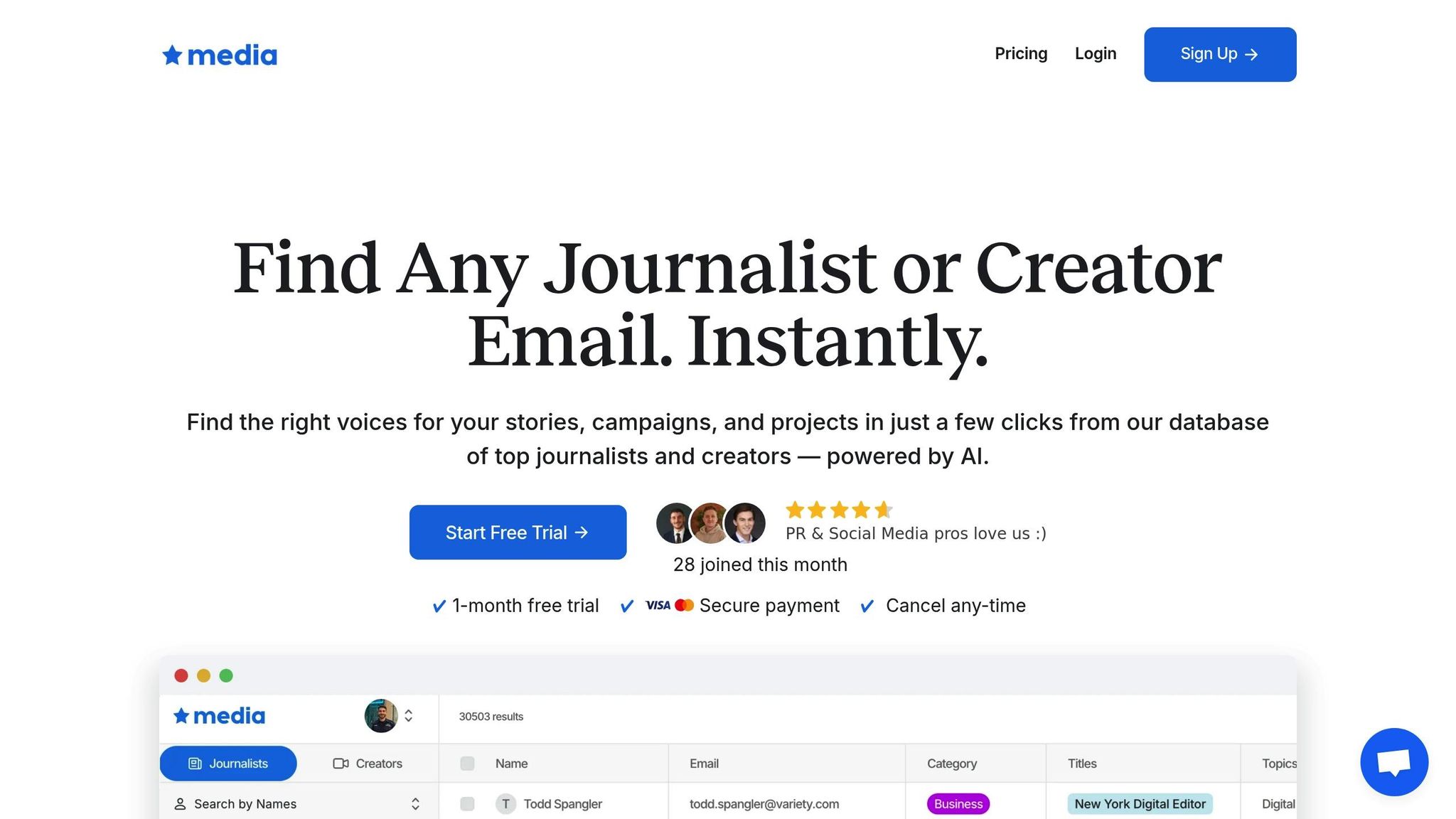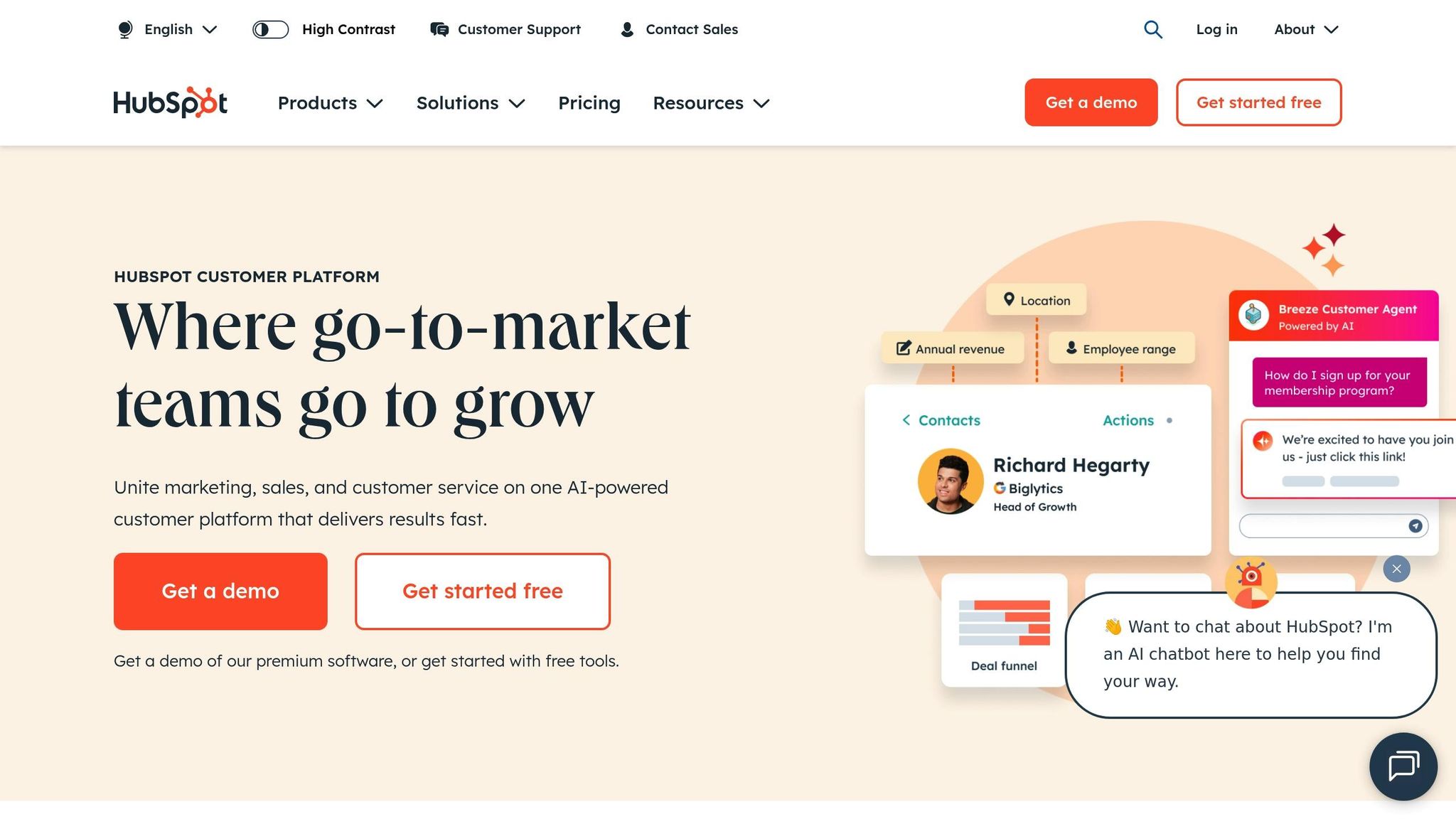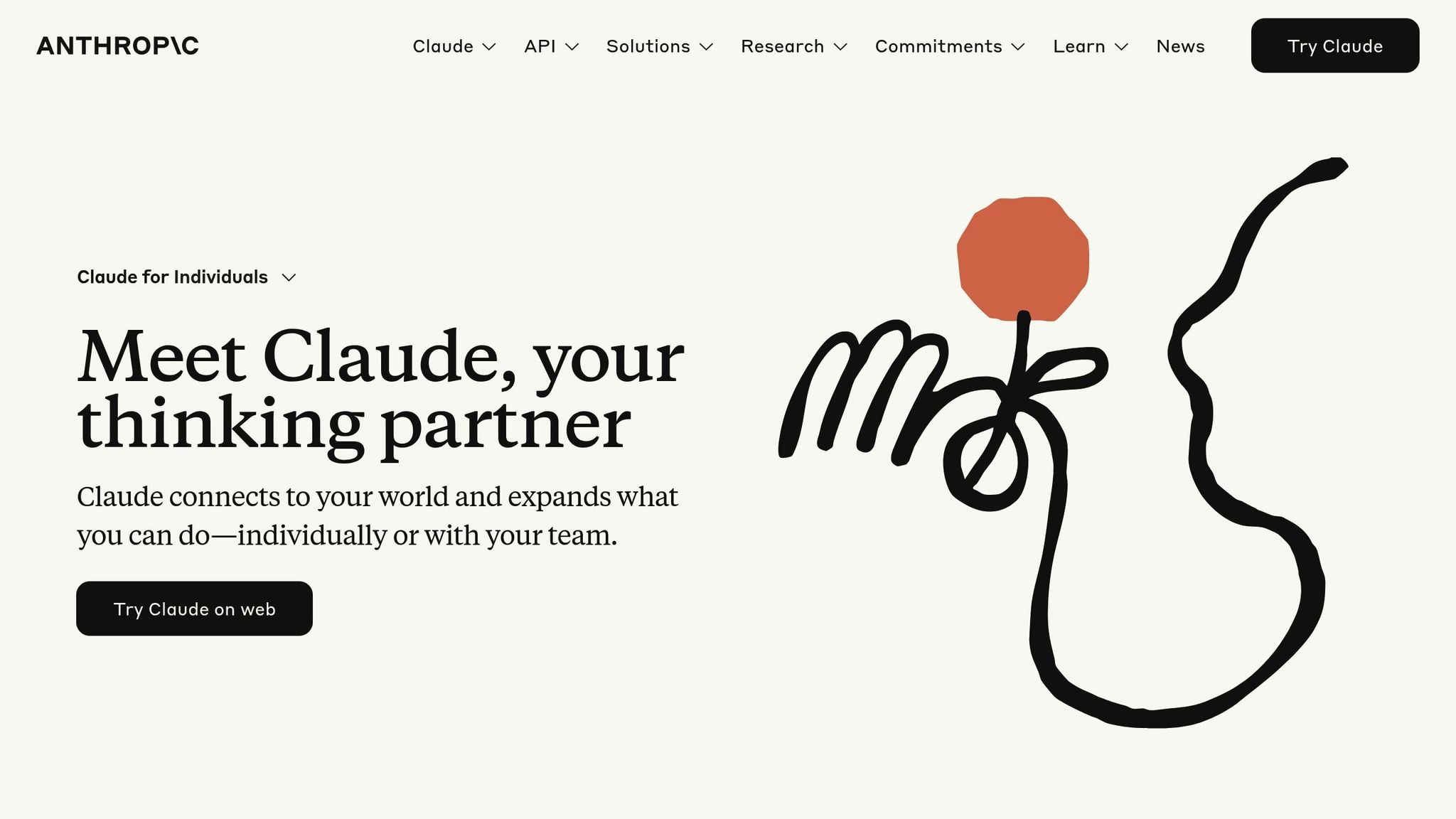Cross-Platform Content Repurposing: AI Strategies
Explore AI strategies for cross-platform content repurposing, optimizing engagement and efficiency across various channels with tailored tools.

AI tools make repurposing content for different platforms faster and simpler. They help transform a single piece of content, like a press release or blog post, into tailored formats for platforms like Twitter, LinkedIn, and Instagram. This saves time, ensures consistency, and boosts engagement.
Key tools include:
- Media AI: Connects users with 30,000+ journalists and creators for platform-specific messaging. Pricing starts at $99/month.
- HubSpot Content Remix: Built into HubSpot, reshapes long-form content for multiple platforms. Best for existing HubSpot users.
- Claude: An AI writing assistant that adjusts tone and format for each platform, offering flexibility for nuanced needs.
- Zemith: Its capabilities and legitimacy are unclear, making it a risky choice.
Quick Comparison:
| Tool | Best For | Pricing | Limitations |
|---|---|---|---|
| Media AI | PR and influencer outreach | $99-$149/month | Doesn’t transform content |
| HubSpot Remix | HubSpot users | Part of HubSpot | Requires HubSpot ecosystem |
| Claude | Complex content transformation | Subscription | Needs custom workflows |
| Zemith | Not recommended | Unclear | No verified capabilities |
To pick the right tool, consider your goals, budget, and current systems. Combining tools can maximize results. For instance, Media AI’s network can complement Claude’s content transformation abilities.
How To Repurpose Content with AI [Real Examples] : Copy My Workflow
1. Media AI

Media AI takes content distribution to the next level by connecting PR professionals with creators who know how to tailor messages for different platforms. This AI-driven system works hand-in-hand with broader content repurposing strategies, ensuring that content reaches the right audience through the best collaborators.
Content Adaptation Capabilities
One of Media AI's standout features is its ability to link users with the perfect creators and journalists from a vast network of over 30,000 professionals. Whether it's transforming a formal press release into an eye-catching Instagram post or simplifying a technical announcement into a digestible blog, this platform makes it happen.
The AI-powered filtering system ensures users find collaborators skilled in specific formats. These creators naturally adapt core messages to fit their platform's tone and meet audience expectations, making content resonate more effectively.
Platform-Specific Optimization
Media AI shines when it comes to platform-specific targeting. Users can filter contacts based on their activity and influence on platforms like Instagram, Twitter, LinkedIn, or YouTube. For example, Instagram creators are ideal for visual campaigns, while Twitter journalists excel at breaking news, and YouTube influencers are perfect for long-form educational content. This ensures the content feels native to each platform.
The filtering options go beyond just platforms. Users can refine searches by audience demographics and engagement rates, helping them identify creators whose followers match their target market. For instance, LinkedIn influencers with a B2B decision-maker audience can be easily pinpointed for professional campaigns.
Scalability and Automation
Media AI simplifies campaign execution by automating the process. Users can quickly filter the database, export contact lists, and launch campaigns across multiple platforms with ease. The platform’s batch export feature supports simultaneous rollouts, saving time and effort.
This streamlined approach not only reduces manual work but also makes it easier to manage diverse campaigns. Whether you're targeting multiple platforms or running a single-channel initiative, Media AI’s automation tools make the process efficient.
Pricing and Accessibility
Media AI offers flexible pricing plans to meet different needs and budgets. Users can choose between the Journalist Database or Creators Database plans, each priced at $99 per month, or opt for the Full Database plan at $149 per month, which combines both segments. All plans include advanced filtering, export capabilities, and the freedom of no contract commitments.
This month-to-month pricing model is especially appealing for smaller organizations or freelancers trying out AI-powered tools for the first time. At the same time, the comprehensive database ensures that larger agencies and enterprises can access the full range of media contacts needed for large-scale, cross-platform campaigns. It’s a solution designed to be both flexible and accessible.
2. HubSpot Content Remix

HubSpot Content Remix takes long-form content and transforms it into formats that are ready to shine on different platforms. Built directly into HubSpot's marketing suite, this tool fine-tunes tone, structure, and format to help your content go further.
How It Adapts Content
This tool dives into lengthy pieces - think blog posts or whitepapers - and pulls out the most important insights. It then reshapes them into shorter, punchier formats while keeping the original message and brand voice intact.
Optimized for Every Platform
HubSpot Content Remix doesn't just shorten content - it tailors it to fit the unique style and best practices of each platform. Whether it's a professional audience on LinkedIn or a visually driven crowd on Instagram, the tool ensures your message hits the mark. This customization aligns perfectly with broader automation strategies, making your content work smarter, not harder.
Built for Scale
By integrating with HubSpot's marketing suite, Content Remix uses automation to simplify how content gets distributed. It allows teams to repurpose entire libraries of material and schedule platform-ready posts across multiple channels - all with minimal manual effort.
Unlike tools that just focus on connecting professionals, HubSpot Content Remix stands out by reshaping content formats within a fully integrated system, making it a game-changer for marketers looking to maximize their reach.
3. Claude

Claude brings a conversational and intuitive approach to content repurposing, acting as a reliable writing assistant. Created by Anthropic, this AI tool is built to grasp context and ensure your brand voice remains consistent across different content formats.
How Claude Adapts Content
Claude excels at analyzing the core message of your content and reshaping it to fit various platforms. For example, a detailed case study could be turned into a series of LinkedIn posts that spotlight key findings or distilled into short, engaging Twitter threads with actionable insights.
The tool’s conversational interface allows for real-time feedback and fine-tuning. Need a more relaxed tone for Instagram? Or maybe you want to add extra data for a LinkedIn post? Claude can handle those tweaks effortlessly, ensuring your content feels right for each audience. This flexibility makes it a go-to resource for refining platform-specific strategies.
Optimized for Every Platform
Claude tailors content to suit the unique style of each social platform. It crafts concise, punchy updates for Twitter, adopts a professional tone for LinkedIn, and aligns with Instagram’s visual and hashtag-driven trends.
Beyond formatting, Claude can even analyze engagement patterns and suggest the best times to post, helping you maximize visibility and interaction on each channel.
Pricing and Usability
Claude is designed to be accessible and user-friendly, offering a subscription model that works for a range of users - from solo creators to larger teams. Its straightforward interface doesn’t require technical expertise, making it a practical choice for entrepreneurs and small marketing teams looking to streamline content repurposing without a steep learning curve.
4. Zemith
When analyzing AI platforms, it's crucial to assess both their legitimacy and capabilities. Zemith does not appear to be a known AI platform specifically designed for cross-platform content repurposing. This absence from the competitive landscape underscores the importance of thoroughly evaluating platforms before committing resources to them.
Content Adaptation Capabilities
There’s no verified documentation or user feedback available to confirm Zemith's content adaptation features. This makes it even more important to conduct proper research when selecting AI tools. Established platforms typically provide clear documentation, user testimonials, and case studies that showcase their capabilities.
When assessing any AI tool, look for tangible evidence of its content adaptation features. This might include examples of format conversions, lists of supported formats, or details about how the tool integrates with existing workflows. The lack of such information about Zemith serves as a reminder that not all AI platforms live up to their claims.
Platform-Specific Optimization
Proven AI tools often offer detailed insights into their optimization processes, such as performance metrics, supported platforms, and measurable results. In contrast, Zemith offers no such transparency. Without clear evidence of platform-specific optimization capabilities, businesses risk investing in tools that may fall short of delivering the desired cross-platform effectiveness.
This highlights the value of choosing established platforms that provide detailed descriptions of their algorithms, supported social media networks, and the outcomes users can expect.
Scalability and Automation
There’s no indication that Zemith supports enterprise-level scalability or advanced automation. This lack of documentation raises questions about whether the platform can handle large-scale operations or even exists as a viable solution.
For businesses seeking enterprise-grade tools, this uncertainty reinforces the need to prioritize platforms that clearly outline their infrastructure, processing power, and automation capabilities. Established AI platforms typically provide detailed specifications about their scalability and enterprise support, ensuring they can meet the demands of larger organizations.
Pricing and Accessibility
Zemith's pricing structure and accessibility remain unclear, which further highlights the importance of working with platforms that are transparent about their costs and market presence.
These gaps in information emphasize why businesses should lean toward established AI solutions for reliable and effective content repurposing across platforms.
Advantages and Disadvantages
AI platforms bring distinct strengths and challenges to the table. The key is to select tools that align with your specific goals and workflows.
Media AI is a standout for connecting creators with over 30,000 journalists and influencers, making it a go-to for PR and influencer outreach. It simplifies contact discovery and relationship-building processes, but it’s not designed for transforming content. Pricing starts transparently at $99 per month for individual databases, or $149 for full access, making it an accessible option for smaller teams.
HubSpot Content Remix integrates seamlessly with HubSpot’s Content Hub, offering a unified analytics experience and familiar workflows. It handles various content formats, from blog posts to social media snippets, with ease. However, its reliance on the HubSpot ecosystem can be a drawback for those looking for standalone solutions.
Claude shines in generating human-like text and adapting long-form content while maintaining emotional depth. That said, it requires custom workflows for efficient and systematic repurposing, which can be a hurdle for some teams.
Zemith raises concerns due to its lack of verified capabilities and clear documentation, making its legitimacy questionable.
Here’s a quick comparison of these platforms:
| Platform | Advantages | Limitations | Best Use Case |
|---|---|---|---|
| Media AI | Large journalist/creator database; efficient PR workflows; no contracts needed | Limited to relationship building; not designed for content transformation | PR campaigns and influencer outreach |
| HubSpot Content Remix | Seamless integration with HubSpot; unified analytics; familiar workflows | Requires HubSpot ecosystem; less flexible for standalone use | HubSpot users seeking integrated content solutions |
| Claude | Superior text generation; emotional depth; handles long-form content well | Requires custom workflows for systematic repurposing | Complex content adaptation with nuanced needs |
| Zemith | None verified | Unclear legitimacy; no documented capabilities | Not recommended |
Choosing the Right Tool for Your Needs
The best AI tool for you depends on your existing infrastructure and strategic goals. For businesses already using HubSpot, HubSpot Content Remix offers a seamless solution that leverages familiar workflows. If your focus is on building relationships and distributing content, Media AI’s extensive database and PR features are highly appealing. Meanwhile, teams with advanced content transformation needs might benefit from Claude, provided they’re ready to invest in custom workflows.
Cost Considerations
Pricing is another critical factor. Media AI stands out with its transparent, no-commitment pricing, making it a great choice for freelancers and smaller agencies. In contrast, HubSpot Content Remix is bundled into broader Content Hub subscriptions, which may represent a higher upfront cost but deliver comprehensive content management benefits. Claude, on the other hand, typically uses a usage-based pricing model, which scales according to the volume of content being repurposed.
Final Thoughts
No single platform can meet every content repurposing need. A well-rounded strategy often involves combining multiple tools, leveraging their strengths, and addressing their limitations with thoughtful integration and custom workflows. By doing so, you can create a tailored approach that aligns with your goals and maximizes the potential of these AI tools.
Conclusion
AI-driven content repurposing offers customized solutions tailored to specific campaign goals. The key to success lies in selecting the right tool for the job. For PR professionals and agencies focused on building relationships and distributing content, Media AI shines. Its transparent pricing makes it appealing to smaller teams and freelancers who need flexibility.
If you're already using HubSpot, Content Remix is a natural fit. It integrates seamlessly with existing workflows and provides unified analytics, making it a great choice for teams that value efficiency within their established systems.
For more intricate content transformations that require a nuanced touch, Claude is a strong contender. However, it often works best when paired with custom workflows designed to meet unique requirements.
On the other hand, Zemith lacks clear documentation and verified credibility, raising questions about its suitability for professional use. This review underscores the specific strengths each tool brings to a larger content strategy.
When making a strategic choice, consider the following: Media AI is ideal for outreach and relationship-building, HubSpot Content Remix excels in enhancing workflows, and Claude handles complex transformations with precision. Together, these tools illustrate how thoughtful selection can amplify cross-platform campaign success.
A multi-tool approach can be especially effective. For instance, Media AI’s relationship-building capabilities can complement Claude’s advanced transformation features, while HubSpot users might integrate Media AI’s database to expand their reach. By combining these tools, businesses can harness their individual strengths and overcome limitations through smart integration.
FAQs
How can AI tools help repurpose content effectively across different platforms?
AI tools make content repurposing faster and simpler by automating the process of reshaping content for different platforms. For example, a single blog post can be turned into engaging social media updates, eye-catching videos, or even informative infographics. This approach ensures your message connects with various audiences while keeping your brand's tone and style consistent.
Using AI, businesses can expand their content’s reach, boost engagement, and streamline workflows - all while getting more value from their efforts. These tools not only customize content to fit each platform’s unique demands but also maintain a polished and unified presence across all channels.
What should you look for in an AI tool to effectively repurpose content across platforms?
When selecting an AI tool for content repurposing, focus on its ability to manage various formats and platforms while fitting smoothly into your current workflows. It’s important that the tool ensures consistent content quality, adjusts tone and style to suit different audiences, and enhances SEO and engagement efforts.
You’ll also want features that support efficient content scaling, uphold your brand’s voice, and offer actionable insights to boost performance. The right AI tool can help you get the most out of your content by tailoring it for each channel - saving both time and resources while improving your ROI.
Why is it important to ensure AI tools like Zemith are reliable before using them for cross-platform content repurposing?
Why Verifying AI Tools Like Zemith Matters
Making sure AI tools like Zemith are reliable isn't just a nice-to-have - it’s essential. Using unverified platforms can lead to inaccurate or biased content, which could tarnish your brand’s reputation or even create compliance headaches. Beyond that, poorly vetted tools might open the door to security risks, potentially exposing sensitive data or spreading misinformation.
When you take the time to verify an AI platform’s legitimacy and capabilities, you’re not just protecting your content’s accuracy. You’re also building trust with your audience and staying aligned with legal and ethical standards. In the end, this ensures your content repurposing efforts remain both effective and secure, all while safeguarding your business’s reputation.





